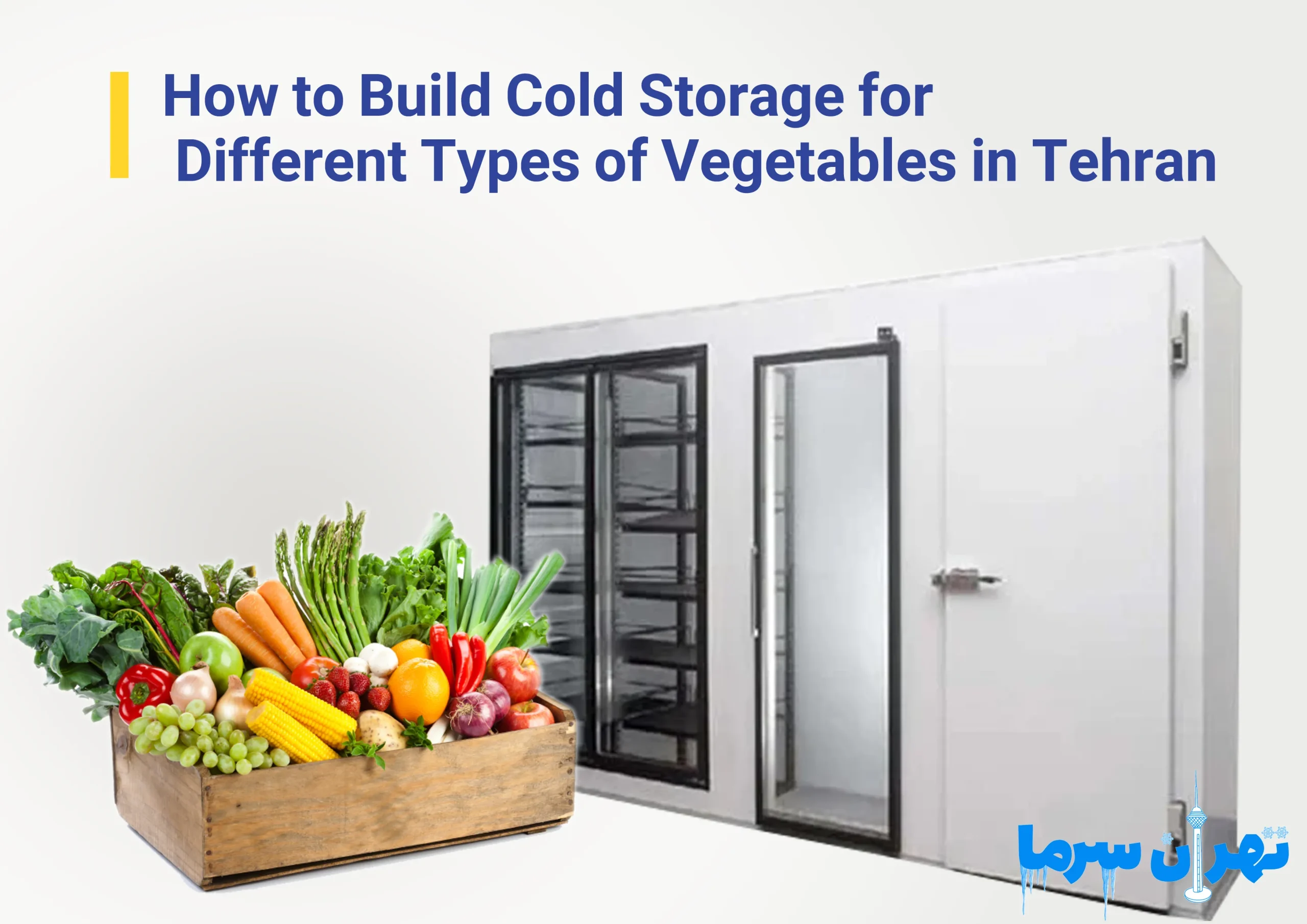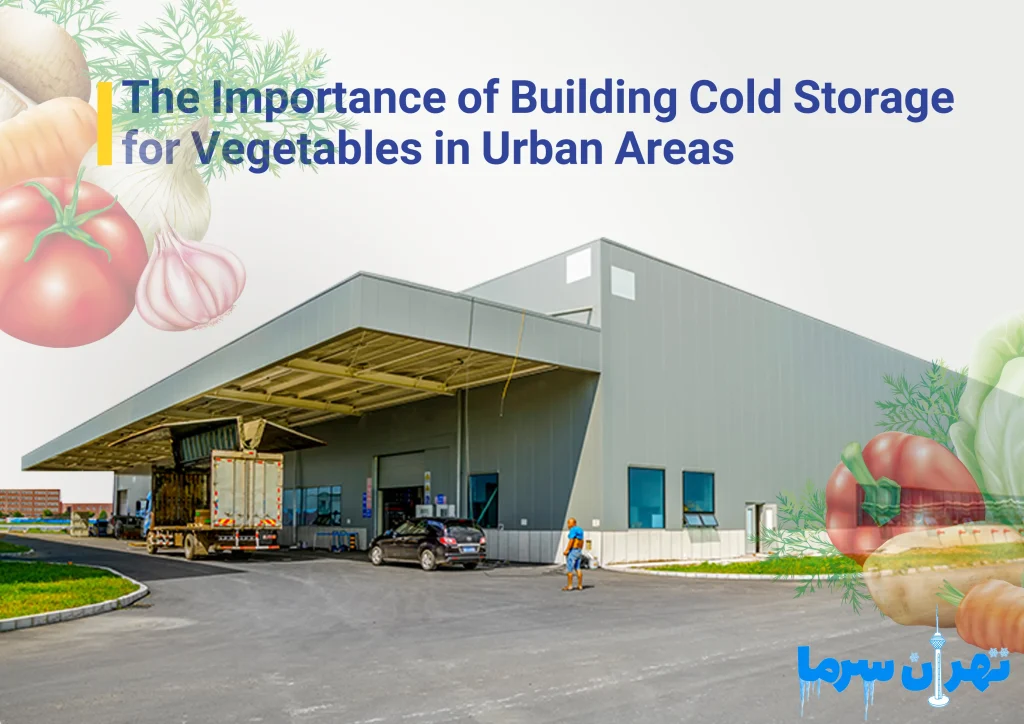How to Build Cold Storage for Different Types of Vegetables in Tehran

Building cold storage for various vegetables is one of the essential requirements for maintaining the quality of these products. Constructing cold storage for vegetables helps farmers and distributors prevent waste and store products under ideal conditions. The construction of cold storage for vegetables in Tehran, using modern and up-to-date equipment, has become one of the most in-demand services in this field.
Building cold storage for vegetables in Tehran is a process that requires a thorough understanding of climatic conditions, market demand, and the specific characteristics of agricultural products. Tehran, being one of the most populous cities in the country, has a large consumer market for various vegetables, which makes the presence of specialized infrastructures like cold storage even more important.
To maintain the quality and freshness of these products, utmost care must be taken in the design and implementation of cold storage to prevent quality degradation, color changes, decay, or loss of nutritional value of vegetables.
- Choosing the Right Location for Building Cold Storage for Vegetables
The first step is to select an appropriate location for constructing cold storage. In Tehran, proximity to distribution centers and the consumer market is a determining factor. Additionally, access to infrastructure such as industrial electricity, water, and transport routes also influences the site selection. The chosen land should allow for the possibility of future expansion of the cold storage.
After selecting the location, the technical design of the cold storage begins. Specific conditions must be met to store vegetables, such as appropriate temperature, controlled humidity, and uniform air circulation. Vegetables, due to their delicate structure and high water content, are very vulnerable, and any disturbance in storage conditions may lead to rapid spoilage. Therefore, the cooling system must be able to precisely control temperature and humidity to ensure optimal conditions for each type of vegetable.
- The Importance of Insulation in Building Cold Storage for Vegetables
Using high-quality insulation materials in the construction of cold storage for vegetables is crucial to prevent air leakage and energy loss. Installing automatic doors, alarm systems, and remote control equipment are part of the modern technologies used in today’s cold storage. These elements are economically justified in Tehran, where energy and labor costs are high, and they help save on maintenance expenses.
- Training Staff for Cold Storage Operations for Vegetables in Tehran
Ultimately, the successful operation of a cold storage facility depends on the execution and management team. Specialists must carefully monitor the performance of cooling systems, safety, hygiene, and the entry and exit of products. Training staff on proper vegetable storage and quick responses to problems is also essential for efficient operation. Therefore, building cold storage for vegetables in Tehran is not just about constructing a cold space, but rather a multi-stage and specialized process that requires careful planning and execution.
The Importance of Building Cold Storage for Vegetables in Urban Areas
Building cold storage for vegetables in urban areas is important from several perspectives and plays a key role in the food supply chain. With the rapid growth of urban populations and the increasing demand for fresh products, the need for infrastructure that can store these products under suitable conditions has never been more apparent.
Vegetables, due to their perishable nature, require precise storage and specific temperature and humidity conditions. Cold storage facilities act as intermediaries between producers and consumers, ensuring the quality, safety, and sustainable access to these products.
In urban areas, the distance between production centers and the consumer market is often large. Without cold storage, a portion of the products may be damaged or spoiled during transportation or at distribution points. The construction of cold storage facilities in such areas not only helps preserve the freshness of vegetables but also reduces waste and resource loss.
This is particularly evident in large cities like Tehran, where the high demand and product diversity necessitate standard storage systems. Furthermore, building cold storage for vegetables in urban areas helps regulate the market. Vegetables experience significant price fluctuations, especially during harvest season. With cold storage, surplus products can be stored and gradually released to the market, helping stabilize prices and prevent market shocks. This way, farmers do not suffer losses, and consumers benefit from more reasonable prices.
Urban cold storage facilities can also serve wholesale distribution centers, chain stores, restaurants, and food processing units. This widespread interaction provides a competitive advantage, especially in the economic fabric of cities. Additionally, well-equipped cold storage facilities in urban areas play a vital role in preventing secondary contamination and maintaining public health.
Finally, it should be noted that building cold storage for vegetables in urban areas is not just an engineering or technical project, but a strategic necessity for urban sustainable development and food security. This initiative improves the quality of life for city residents, reduces pressure on resources, and supports national agriculture. Therefore, attention to this critical infrastructure should hold a prominent place in future urban and agricultural planning.
Examining Climatic Conditions and Consumer Market in Tehran and Their Impact on Designing and Building Cold Storage for Vegetables
Examining climatic conditions and the consumer market in Tehran plays a crucial role in designing and constructing cold storage for vegetables. Tehran is known for its semi-arid climate, with hot summers and cold winters, conditions that present both advantages and challenges for storing agricultural products.
These climatic conditions require the cooling systems used in cold storage to handle extreme temperature fluctuations and provide a stable, controlled environment for vegetable storage. The use of strong thermal insulation, high-efficiency ventilation systems, and advanced cooling equipment is essential, directly stemming from Tehran’s climate.
Along with the climate, Tehran’s consumer market also significantly impacts the type and design of cold storage for vegetables. As the capital and one of the most densely populated cities in the country, Tehran has a vast and diverse consumer market for vegetables. From urban families to restaurants, chain stores, and food industries, all require continuous access to fresh products.
This extensive demand means that cold storage facilities must be designed to have high storage capacity and allow for the quick and orderly movement of products. Smart management systems, modular design, and the ability to segment spaces for different products are features that must be considered in the design of urban cold storage.
Moreover, the consumption pattern in Tehran also varies seasonally. During certain times of the year, demand for specific vegetables increases, while in other periods, consumption declines. These fluctuations in demand require cold storage facilities to be highly flexible, capable of adapting to the market needs at different times.
Cold storage design must ensure not only high capacity but also the ability to adjust conditions for various vegetables, as each type of vegetable requires specific temperatures for storage.
Environmental challenges and energy limitations in Tehran should not be overlooked. Given the high electricity consumption of cooling equipment, cold storage design must prioritize energy efficiency. Utilizing modern energy control systems, heat recovery technologies, and smart technologies to reduce electricity consumption in the construction of cold storage for vegetables can significantly optimize the performance of these facilities. This is particularly important in a city like Tehran, which faces energy resource limitations.
Designing and constructing cold storage for vegetables in Tehran cannot be done without a thorough understanding of climatic conditions and the consumer market. These two factors, as the main foundations of the design, impact all technical, economic, and operational aspects of the project.
By considering both environmental conditions and market needs, an efficient, sustainable cold storage system can be designed and built, playing a vital role in ensuring food security, reducing waste, and ensuring a steady supply of fresh products.
Types of Cooling Systems Used in Building Cold Storage for Various Vegetables
Various cooling systems are used in the construction of cold storage for vegetables, each selected based on the specific needs and environmental conditions. The most common systems include vapor compression systems, absorption systems, and refrigeration systems using ammonia or freon gases.
The vapor compression system, due to its high efficiency and precise temperature control capability, is a widely used option in vegetable cold storage. In some large cold storage facilities, central refrigeration systems using ammonia are employed, which, in addition to effective performance, offer significant energy savings. The choice of cooling system depends on factors such as the cold storage capacity, the type of vegetables, the climatic conditions of the construction site, and maintenance costs.
Technical Considerations in Building Cold Storage for Vegetables, Including Temperature, Humidity, and Ventilation
In building cold storage for vegetables, adhering to technical considerations such as temperature, humidity, and ventilation is critical because these factors directly affect the quality and shelf life of the products. Each type of vegetable requires a specific temperature for storage. For example, leafy vegetables are typically best preserved at temperatures between 0°C and 4°C, while vegetables like eggplant or peppers require a higher temperature.
In addition to temperature, controlling relative humidity is also essential because low humidity can cause wilting, while high humidity leads to decay and fungal growth. Proper ventilation must be designed to ensure uniform air circulation throughout the cold storage, preventing the creation of hot or humid spots. The use of sensors and smart environmental control systems helps maintain the stability of these parameters and increases the efficiency of the cold storage.
Why Choose Tehran Sarma Engineering Company for Building Cold Storage for Various Vegetables?
Choosing Tehran Sarma Engineering Company for building cold storage for vegetables is a smart and reliable decision, as this company utilizes modern technical knowledge, extensive experience in industrial projects, and advanced equipment to provide specialized solutions tailored to each customer’s needs.
The engineering team at Tehran Sarma has a precise understanding of Tehran’s climatic conditions, market consumption patterns, and the sensitive nature of vegetables. They design and construct cold storage facilities that, while maintaining product quality, are also energy-efficient and cost-effective. Professional consulting services, technical support, and a commitment to delivering projects on time are other reasons that make this company a trusted choice in this field.
For more information about cold storage construction prices, you can visit the Tehran Sarma website and contact us at the following numbers: 09121906418 and 02177972256.
Building cold storage for vegetables plays an important role in the agricultural product supply chain and helps preserve their freshness and quality. Constructing cold storage for vegetables, considering the specific needs of each product type, helps reduce waste and increase efficiency. Due to high consumption and the importance of proper product storage, the construction of cold storage for vegetables in Tehran is rapidly expanding.
Source:
https://www.coldstorageus.com/




 سردخانه
سردخانه برق
برق کمپرسور
کمپرسور کمپرسور بیتزر
کمپرسور بیتزر کمپرسور کوپلند
کمپرسور کوپلند کمپرسور بوک
کمپرسور بوک کمپرسور دانفوس
کمپرسور دانفوس کمپرسور منیروپ دانفوس
کمپرسور منیروپ دانفوس کمپرسور امبراکو
کمپرسور امبراکو کمپرسور پاناسونیک
کمپرسور پاناسونیک کمپرسور سابکول
کمپرسور سابکول کمپرسور کوپلند
کمپرسور کوپلند کمپرسور اسکرال کوپلند
کمپرسور اسکرال کوپلند کمپرسورفراسکلد
کمپرسورفراسکلد کمپرسور رفکامپ
کمپرسور رفکامپ کمپرسور اسکرال دانفوس
کمپرسور اسکرال دانفوس گاز مبرد
گاز مبرد گاز R22
گاز R22 گاز R134
گاز R134 گاز R404
گاز R404 گاز R407
گاز R407 گاز R410
گاز R410 گاز R508
گاز R508 کندانسور هوایی
کندانسور هوایی اواپراتور
اواپراتور اواپراتور آرشه
اواپراتور آرشه اواپراتور صابکول
اواپراتور صابکول اواپراتور آسه
اواپراتور آسه اواپراتور نیک
اواپراتور نیک اواپراتور آرتک
اواپراتور آرتک اواپراتور نوین
اواپراتور نوین اواپراتور تبادل کار
اواپراتور تبادل کار درب
درب ساندویچ پنل
ساندویچ پنل فن سردخانه
فن سردخانه روغن کمپرسور سانیسو
روغن کمپرسور سانیسو متعلقات سردخانه
متعلقات سردخانه